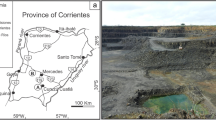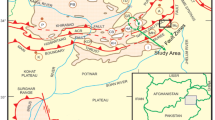Abstract
The present study envisages the potential alkali–silica reactivity; the most common form of alkali aggregate reaction of various aggregate sources of Kashmir and mitigation measures thereof using petrographic analysis and various designated ASTM codes. The chemical analysis was carried out for different aggregate samples possessing different lithology hence varied reactive nature. Comparatively some samples showed more reactive nature than others due to presence of higher reactive silica. The results show the innocuous nature of all aggregate samples according to ASTMC-289 standard curve. The study reveals that addition of Fly ash reduced the elongation of bars resulted due to alkali silica reactivity of the aggregates and hence should be widely used as a mitigation measure to overcome the alkali reactive nature of the aggregates in the region.




Similar content being viewed by others
References
ASTM. ASTM C 1260-94. (1999). Standard test method for potential alkali reactivity aggregate (mortar.-bar method). Annual Book of ASTM Standards (p. 156462). West Conshohocken, PA: American Society for Testing Materials.
ASTM., ASTM C 289–9, (1999). Standard test method for potential alkali reactivity of aggregate (chemical method). Annual Book of ASTM Standards (p. 156462). West Conshohocken, PA: American Society for Testing Materials.
Barkavi, T., & Natarajan, C. (2018). Knowledge-based decision support system for identification of crack causes in concrete buildings Asian. Journal of Civil Engineering, 19(2), 111–120.
Castro, N., & Wigum, B. J. (2012). Assessment of the potential alkali-reactivity of aggregates for concrete by image analysis petrography. Cement and Concrete Research, 42(12), 1635–1644.
Dent-Glasser, L. S., & Kataoka, N. (1981). The chemistry of alkali-aggregate. Cement and Concrete Research, 11(1), 1–9.
Dent-Glasser, L. S., & Kataoka, N. (1982). On the role of calcium in the alkali_aggregate reaction. Cement and Concrete Research, 12(3), 321–331.
Diamond, S. (1981). Effect of two Danish fly ashes on alkali contents of pore solutions of cement-fly ash pastes. Cement and Concrete Research, 11(3), 383–394.
Farny, J., & Kerkhoff, B. (2007). Diagnosis and control of alkali-aggregate reactions in concrete, IS413. Skokie, IL: Portland Cement Association.
Guru Jawahar, J., Yakshareddy, B., Sashidhar, C., SreenivasuluI, C., & Ramana, Reddy V. (2018). Evolution of 112-day drying shrinkage equation of fly ash blended self-compacting concrete. Asian Journal of Civil Engineering, 19(6), 703–712.
Heidari, A., Hashempour, M., Javdanian, H., & Karimian, M. (2018). Investigation of mechanical properties of mortar with mixed recycled aggregates. Asian Journal of Civil Engineering, 19(5), 583–593.
Hobbs, D. W. (1988). Alkali-silica reaction in concrete. London: Thomas Telford.
Kanthe, V. N., Deo, S. V., & Murmu, M. (2018). Effect of fly ash and rice husk ash on strength and durability of binary and ternary blend cement mortar. Asian Journal of Civil Engineering, 19(8), 963–970.
Kurihara, T., & Katawaki, K. (1989). Effect of moisture control and inhibition on alkali-silica reaction. In Proclamation, 8th international conference on alkali aggregate reaction in concrete, Kyoto, Japan (pp. 629–634).
Larive, C., Laplaud, A., & Coussy, O. (2000). The role of water in alkali-silica reaction. In Proclamation, 11th international conference on alkali -aggregate reaction in concrete, Quebec City (pp. 61–69).
Oberholster, R.E. (1992). The effect of different outdoor exposure conditions on the expansion due to alkali-silica reaction. In Proclamation, 9th international conference on alkali aggregate reaction in concrete, Slough (pp. 623–628).
Olafsson, H. (1986). The effect of relative humidity and temperature on alkali expansion of mortar bars. In: Proclamation, 7th international conference on alkali aggregate reaction in concrete, Ottawa (pp. 461–465).
Poulsen, E., Hansen, T., & Sorensen, H. (2000). Release of alkalies from feldspar in concrete and mortar. In Proclamation, 5th international conference on durability of concrete, Barcelona (pp. 807–824).
Shehata, M. H., Thomas, M. D. A., & Bleszynski, R. F. (1999). The effect of fly ash composition on the chemistry of pore solution in hydrated cement paste. Cement and Concrete Research, 29(12), 1915–1920.
Shon, S., & Zollinger, D. G. (2004). Testing the effectiveness of class c and class f fly ash in controlling expansion due to alkali-silica reaction using modified ASTM C 1260 test method. Journal of Materials in Civil Engineering, 16(1), 20–27.
Stanton, T. E. (1940). Expansion of concrete through reaction between cement and aggregate. Proclamation, American Society of Civil Engineering, 66, 1781–1811.
Stark, D., & Bhariy, M. S. Y. (1986). Alkali-silica reactivity: Effect of alkali on aggregate expansion in alkalies in concrete, ASTM STP 930 (pp. 16–30). Philadelphia, PA: American Society for Testing and Materials.
Steffens, A., Li, K., & Coussy, O. (2003). Aging approach to water effect on alkali-silica reaction degradation of structures. Journal of Engineering Mechanics of Materials, 129, 50–59.
Sims, I., & Nixon, P. J. (2003). RILEM recommended test method AAR-0: detection of alkali-reactivity potential in concrete - outline guide to the use of RILEM methods in assessments of aggregates for potential alkali-reactivity. Materials and Structures, 36, 472–479.
Author information
Authors and Affiliations
Corresponding author
Ethics declarations
Conflict of interest
On behalf of all authors, the corresponding author states that there is no conflict of interest.
Additional information
Publisher's Note
Springer Nature remains neutral with regard to jurisdictional claims in published maps and institutional affiliations.
Rights and permissions
About this article
Cite this article
Bukhari, S.K. Potential alkali silica reactivity of aggregates from different sources of Kashmir and mitigation measures thereof. Asian J Civ Eng 20, 437–442 (2019). https://doi.org/10.1007/s42107-019-00117-1
Received:
Accepted:
Published:
Issue Date:
DOI: https://doi.org/10.1007/s42107-019-00117-1




